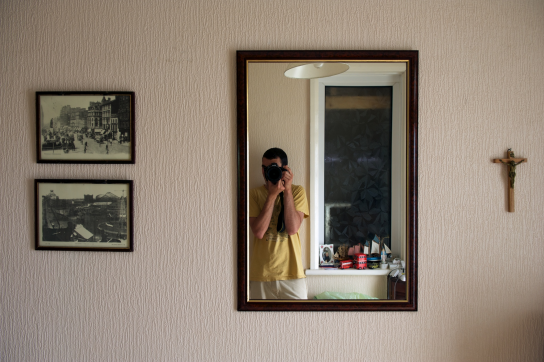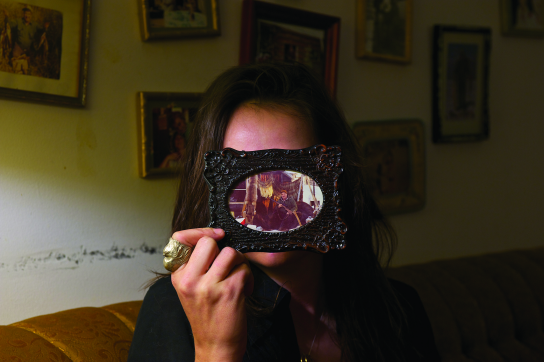By Jennifer Colbourne (The Cascade) – Email
Print Edition: May 23, 2012
Akeem Nermo is one of UFV’s most well-known student photographers. He has had both solo and collective shows at the Fall Gallery, Ethical Addictions, the Toast Collective and of course the UFV Gallery, including the most recent Soon This Space Will Be Too Small grad show. Nermo has twice been selected as a Top College Photographer finalist in Photographer Forum Magazine. Enjoying the warm May sunshine, we sat down at a rickety picnic table outside C building to discuss his work.
Why photography? What is it about that medium that attracted you as an artist?
Originally I was in English – I think I was studying Ginsberg, and I was introduced to a photographer by the name of Robert Frank, a Beat generation photographer … I hadn’t seen photos like that ever before, really analytical but at the same time they had their own character and personality … I felt like I wanted to be in photography rather than English after being exposed to him.
How long have you been doing photography?
For about 10 years – but as fine art photography, maybe about six years.
Do you have other artistic interests?
I like sculpture and print media, even though I’m no good at it. I’m a pretty tactile person and photography doesn’t fulfil that really in any way.
What is your view of photography as art?
There’s an ongoing debate about whether or not photography is art – it’s really a pointless debate: it’s in the institution, photography is in galleries, you learn about it in visual arts classes. [The debate] is still going on because it’s such a democratic medium – anyone can pick up a camera and just press a button and start taking pictures. I don’t think there’s anything wrong with that really. There’s just different ways you can use the tool … You learn a way of seeing and presenting ideas through a camera.
What is your personal approach?
The project that I did in the grad show is totally different from anything I’ve ever done before. [With photographers like] Robert Frank … Lee Friedlander, Nan Golden … the whole focus is just capturing the moment, finding some sort of essence to human life and experience. It’s kind of impossible to do, I think. That’s certainly one way of shooting, but I’m starting to dip my toes into photoconceptual art where the ideas take precedent over the physical content.
What was your inspiration for your project at the grad show?
There are actually three projects. They all exist on their own, but there is a thread that all ties them together. After shooting in that documentary style for several years, [I was] looking back at all these photographs I had, and I didn’t remember what they meant and some meant more—the meaning grew over time—and when different people looked at the same photo that I had experienced this moment with, they would have totally different narratives behind it. I was seeing the failures of photography – you cannot totally compartmentalize a memory and keep it alive. It’s just a document and an artifact, and so much of memory and experience is ephemeral and related to imagination. That’s what I was trying to communicate with this project.
With the first project, Of Endurance & Forgetting, you see all the images that people [are] holding in front of their faces mean a lot to them; you might get an idea of what they mean, but so much of your interpretation is based on your imagination and the narrative really is fatalized in that person.
The memorial one, I had to tiptoe my way around because it’s pretty controversial. It can be taken as exploitative if not done properly. There’s 40 people, there’s 40 lives, you know? But I wasn’t trying to say anything about the people who erected these memorials, like they can’t remember their loved ones. That’s not what I was saying. But as an audience, when you drive by and you see [the memorials] on the side of the road, you don’t know anything other than a person died there. It really runs the risk of defining their life by their death and it kind of bookended the whole series in that we have all these documents that we have to remember our lives and maybe even prove that we exist, but even in death we have more artifacts and shrines [that] we erect to keep our memories alive. They all relate to pictures in general and why we take them.
How did people react to the roadside memorial collection?
When I first started taking [the photos], I wasn’t thinking about the people as much as the project, and near the end of it when I was presenting it, a lot of people approached me and were telling stories about the person, somebody they knew, their own experiences. It got kind of heavy actually … A lot of people mentioned how you had to look up and arch your neck back to see the whole piece – I had more than one person say that it reminded them of being in a cathedral or a church or something. I like that there was some amount of respect that was taken from it. I didn’t want it to be looked at like exploitation at all.
What kind of camera would be your dream camera?
Probably a digital medium format, like a Hasselblad or something, but I don’t have $50,000 … Even if I did have $50,000, the technology changes all the time. It’s not really worth it unless you’re already making a lot of money.
If you could meet any artist in the world, dead or alive, who would it be?
Probably Robert Roshenberg, I really like how he mixed media … I never really liked a whole lot of abstract expressionists from the ’50s, but his works are so visceral and emotive. I’m actually trying to meet an artist, a contemporary one, right now – Jin-Me Yoon. She works at SFU and she influenced a lot of my work.
What are your immediate plans for your art?
One strength that UFV has is building up the conceptual and theoretical background in photography [and] art history background – just exposing you to different ways of seeing. And that’s hard, that’s really hard to learn on your own, but the technical side I think is a bit lacking … so I think I’m going to try to do a photo residency or apprentice with a commercial photographer.






